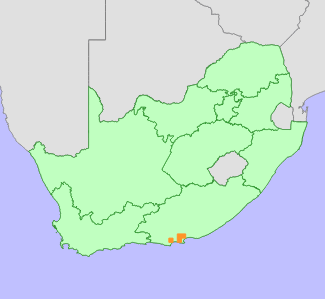|
Scientific Name | Achyranthemum recurvatum (L.f.) N.G.Bergh |
Higher Classification | Dicotyledons |
Family | ASTERACEAE |
Synonyms | Helichrysum recurvatum (L.f.) Thunb., Syncarpha recurvata (L.f.) B.Nord., Xeranthemum recurvatum L.f. |
National Status |
Status and Criteria | Endangered B1ab(ii,iii,iv,v) |
Assessment Date | 2007/03/09 |
Assessor(s) | W. Berrington & J.E. Victor |
Justification | This species has an extent of occurrence (EOO) of 2700 km², and eight severely fragmented subpopulations continue to decline due to cement mining, urban expansion and alien plant invasion. The Coega subpopulation will loose habitat to quarrying as part of the development of the Coega Industrial Zone. It is therefore listed as Endangered under criterion B. |
Distribution |
Endemism | South African endemic |
Provincial distribution | Eastern Cape |
Range | This species occurs in Port Elizabeth, Uitenhage and Addo. |
Habitat and Ecology |
Major system | Terrestrial |
Major habitats | Albany Alluvial Vegetation, St Francis Dune Thicket, Sundays Valley Thicket, Grass Ridge Bontveld |
Description | Plants grow in calcrete pavements. |
Threats |
| The group of plants in the Coega area covers an area of at least 200 hectares. They occur mostly on land, which may be owned by Patcor quarries, and may be mined for calcrete to make cement. The property is vast and threats to the species' immediate future are limited. Plants of this species are very common and probably exceed a million individuals.
At Maitlands River mouth, a small population occurs, which is confined to a small area of less than half a hectare. Single plants occur over a wider area in the vicinity. These plants are threatened by the invasion of alien vegetation.
St. Georges Strand is near the mouth of the Baakens River, and the plants have probably been lost to development.
Another small group has been recorded at the mouth of the Coega River. This group of plants is restricted to an area of less than one hectare. It cannot be confirmed whether these plants still exist, as the site has not been checked since harbour developments began. This was a well-defined subpopulation, probably well in excess of 1000 individuals.
Last year two groups of plants were found, occurring on the western slopes of the Van Stadens River, a few kilometres upstream from the coast. These plants occur on private land and are threatened by heavy invasions of alien vegetation. Each site was smaller than half a hectare. |
Population |
Population trend | Decreasing |
Assessment History |
Taxon assessed |
Status and Criteria |
Citation/Red List version | | Syncarpha recurvata (L.f.) B.Nord. | EN B1ab(ii,iii,iv,v) | Raimondo et al. (2009) | | Syncarpha recurvata (L.f.) B.Nord. | VU D2 | Victor (2002) | | Syncarpha recurvata (L.f.) B.Nord. | Vulnerable | Hilton-Taylor (1996) | | Helichrysum recurvatum (L.f.) Thunb. | Vulnerable | Hall et al. (1980) | |
Bibliography |
Bergh, N.G. and Manning, J.C. 2019. Achyranthemum N.G.Bergh, a new genus segregated from Syncarpha DC. (Asteraceae, Gnaphalieae). South African Journal of Botany 125 434–456.
Goldblatt, P. and Manning, J.C. 2000. Cape Plants: A conspectus of the Cape Flora of South Africa. Strelitzia 9. National Botanical Institute, Cape Town.
Hall, A.V., De Winter, M., De Winter, B. and Van Oosterhout, S.A.M. 1980. Threatened plants of southern Africa. South African National Scienctific Programmes Report 45. CSIR, Pretoria.
Hilton-Taylor, C. 1996. Red data list of southern African plants. Strelitzia 4. South African National Botanical Institute, Pretoria.
Raimondo, D., von Staden, L., Foden, W., Victor, J.E., Helme, N.A., Turner, R.C., Kamundi, D.A. and Manyama, P.A. 2009. Red List of South African Plants. Strelitzia 25. South African National Biodiversity Institute, Pretoria.
Victor, J.E. 2002. South Africa. In: J.S. Golding (ed), Southern African plant Red Data Lists. Southern African Botanical Diversity Network Report 14 (pp. 93-120), SABONET, Pretoria.
|
Citation |
| Berrington, W. & Victor, J.E. 2007. Achyranthemum recurvatum (L.f.) N.G.Bergh. National Assessment: Red List of South African Plants version 2024.1. Accessed on 2025/11/01 |
 Comment on this assessment
Comment on this assessment

